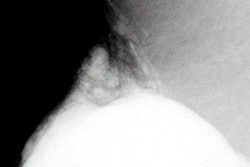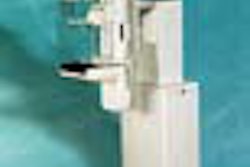
This is the third in a series of coding-specific articles for U.S.-based radiology practitioners. The articles appear each month on AuntMinnie.com, courtesy of Coding Strategies Incorporated. If you'd like to offer your comments about the material, please e-mail us at [email protected].
By: Melody W. Mulaik
Coding Strategies Incorporated

Same-day screening and diagnostic mammograms
The October 31, 1997 Federal Register (1998 Final Rule) states that a physician who meets the qualification requirements for an interpreting physician may order a diagnostic mammogram based on the findings of a screening mammogram, even though the physician does not treat the beneficiary. Effective January 1, 2002, the new GG modifier must be appended to the diagnostic mammogram CPT code (76090 or 76091) when both a screening mammogram and a diagnostic mammogram are performed on the same day.
Both the screening and the diagnostic mammogram should be reimbursed by Medicare. The performance of a diagnostic mammogram on the same day is permissible only when the radiologist notes a suspicious finding on the original screening films. The radiologist may not examine the patient and order a diagnostic mammogram, nor may ancillary staff obtain information from the patient and change the referring physician’s order from a screening to a diagnostic study, without explicit approval from the referring physician.
The use of the GG modifier applies only to those mammograms where a diagnostic study is performed on the same day as the screening service. When the patient is called back to the imaging facility on a different day for additional views, both the original screening and the additional views performed are billed separately (unless written carrier’s instructions state otherwise).
Gamma camera codes for PET
On November 27, 2001, the Centers for Medicare and Medicaid Services (CMS) released Transmittal AB-01-168, Change Request 188 -- The Use of Gamma Cameras and Full Ring and Partial Ring PET Scanners for PET Scans. This decision does not change the covered clinical indications beyond the changes that took effect on July 1, 2001. These new Healthcare Common Procedure Coding System (HCPCS) codes are provided to clarify the type of PET scanner used by clinical indication.
All PET scans are covered for FDA-approved full-ring and partial-ring PET systems. The following scans are covered for certain coincidence systems:
- Characterization of single pulmonary nodules
- Initial staging of lung cancer (NSLC).
- Determining location of colorectal tumors if rising CEA level suggests recurrence.
- Staging or restaging of lymphoma only when used as an alternative to a gallium scan.
- Evaluating recurrence of melanoma prior to surgery as an alternative to a gallium scan.
Certain coincidence systems refer to those systems that have all of the following features:
- Crystal at least 5/8-inch thick.
- Techniques to minimize or correct for scatter and/or randoms.
- Digital detectors and iterative reconstruction.
Certain coincidence systems must have all three design features. Scans performed with gamma camera PET systems with crystals thinner than 5/8-inch will not be covered by Medicare. In addition, scans performed with systems with crystals greater than or equal to 5/8-inch in thickness, but which do not meet the other listed design characteristics, are not covered by Medicare.
Effective January 1, 2002, existing HCPCS codes G0210-G0230 have expanded definitions to include the verbiage "full- and partial-ring PET scanners only" to properly reflect the type of PET scanner used. Also effective January 1, 2002, the following new G codes are utilized to indicate if a gamma camera is used for the PET scan.
- G0231 -- PET, whole body, for recurrence of colorectal or colorectal metastatic cancer; gamma cameras only.
- G0232 -- PET, whole body, for staging and characterization of lymphoma; gamma cameras only.
- G0233 -- PET, whole body, for recurrence of melanoma or melanoma metastatic cancer, gamma cameras only.
- G0234 -- PET, regional or whole body, for solitary pulmonary nodule following CT, or for initial staging of non-small cell lung cancer; gamma cameras only.
Watch for local medical review policies from your carrier regarding medical necessity requirement and utilization of all of the PET scan codes.
New CCI edits
The new version of the Correct Coding Initiative (CCI) edits, Version 8.1, contains a few changes for radiology. The modifications include:
- Fluoroscopy-guided needle placement (76003), and the reconstruction code (76375), are now bundled into 75989 -- Radiological guidance for percutaneous drainage of abscess or specimen collection (for example, fluoroscopy, US, or CT) with placement of catheter, radiological supervision and interpretation.
- The new digitization code for screening mammography (76085) is bundled into diagnostic mammography codes 76090 and 76091.
- The intraoperative ultrasound code (76986) is bundled into the new ultrasound code for guidance for and monitoring of tissue ablation -- 76490.
- The reconstruction code (76375) is now bundled into fetal biophysical profiles (76818-76819), fetal echocardiography (76827-76828), ultrasound of infant hips (76885-76886), and ultrasonic guidance codes (76930-76936).
To ensure that additional codes are not billed inappropriately, all of the following procedures are considered bundled into all CT angiographies and MR angiographies:
- 36000 -- Introduction of needle or intracatheter, vein.
- 36011 -- Selective catheter placement, venous system; first order branch (for example, renal vein or jugular vein).
- 36406 -- Venipuncture, under age 3 years, other vein.
- 90780 -- IV infusion for therapy/diagnosis, administered by physician or under direct supervision of physician; up to one hour.
- 90783 -- Therapeutic, prophylactic, or diagnostic injection (specify material injected); intra-arterial.
- 90784 -- Therapeutic, prophylactic, or diagnostic injection (specify material injected); intravenous.
In addition to the comprehensive and component coding changes, the following mutually exclusive edits were implemented:
- Fluoroscopic guidance for needle placement (76003) may not be billed with basic fluoroscopy (76000 –76001), stereotactic or mammographic guidance for needle placement in the breast (76095-76096), CT-guided needle placement (76360), MR needle placement (76393), or US-guided needle placement (76942).
- Fluoroscopic guidance for spinal injections (76005) may not be billed with MR needle placement (76393) or US-guided needle placement (76942).
- MR-guided needle placement (76393), and US-guided needle placement (76942), may not be billed with mammographic needle placement in the breast (76096). Additionally, MR needle placement may not be billed with stereotactic biopsy or needle placement in the breast (76095).
- CT- and MR-guided needle placements may not be billed together.
- US-guided needle placement (76942), may not be billed with 75989, Radiological guidance for percutaneous drainage of abscess or specimen collection (for example, fluoroscopy, US, or CT) with placement of catheter, radiological supervision and interpretation.
The following mutually exclusive codes were deleted:
- Fluoroscopic needle placements may now be coded with the shoulder arthrography injection code (20550) and the trigger-point injection code (23350).
- Screening mammograms (76092) may now be billed with diagnostic mammograms (76090-76091).
Although these changes are being implemented throughout the U.S., it's important to remember that many individual payors will develop their own policies for medical necessity issues related to billing both mammograms and the new PET codes. As with all coding guidance, individual payor policies should be obtained in writing to ensure compliance with payor guidelines.
By Melody MulaikAuntMinnie.com contributing writer
January 18, 2002
Melody Mulaik is president of Coding Strategies Incorporated. Her company will be presenting its comprehensive radiology-only workshop networking (CROWN) seminar series February 18 - 22 in Dallas. The company can be contacted at 877-626-3464 for further information.
Related Reading
New diagnosis guidelines could affect your operations and reimbursement, December 18, 2001
Order compliance equals payment for outpatient radiologists, November 19, 2001
Copyright © 2002 Coding Strategies Incorporated



















